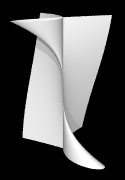 The moving image at the top of the mathematics 535 home page during
the fourth week shows an affine real locus of the a surface projectively
equivalent to the projection of the Veronese surface from the line
to P^3. We saw this Cayley ruled surface in Week 4 as the second from
the right among the projections of the Veronese.
The moving image at the top of the mathematics 535 home page during
the fourth week shows an affine real locus of the a surface projectively
equivalent to the projection of the Veronese surface from the line
to P^3. We saw this Cayley ruled surface in Week 4 as the second from
the right among the projections of the Veronese.
We call a point on a hypersurface F=0 a singular point if the gradient of F vanishes at that point. Note that if a cubic surface in P^3 has 4 singular points in general position up to projective equivalence we may assume that they are the standard points [1,0,0,0],[0,1,0,0],[0,0,1,0] and [0,0,0,1] and then each partial derivative vanishing gives 4 linear equations in the 20 coefficients of the homogeneous cubic, giving a 4 dimensional space of cubic homogeneous polynomials which have these 4 points singular. This space is clearly spanned by the cubic monomials of degree 1 at most in each variable. Any sum of 3 such is reducible (each leaves out only 1 of the 4 variables) and sum of nonzero multiples of all 4 gives a surface projectively equivalent to x_0x_1x_2+x_0x_1x_3+x_0x_2x_3+x_2x_2x_3=0. This surface has exactly 4 singular points. so all irreducible cubic surfaces in P^3 which have 4 singular points in general position are projectively equivalent and have exactly 4 singular points. Cayley discovered the surface 4(x_0^3+x_1^3+x_2^3+x_3^3)-(x_0+x_1+x_2+x_3)^3 which is of this type, now called the Cayley Cubic Surface. The University of Turin site mentioned above has an animation showing several transformations of cubic surfaces with 4 singular points in general position. Click on one of the peripheral surfaces to see the transformation of the central surface.
Note that the singular points of a cubic surface are intersections of the cubic with quadrics given by taking the various derivatives. Hence if 3 singular points are on a line, the whole line is in the cubic and in any quadrics containing the three points, hence the entire line is singular. Similarly the line joining 2 singular points on a cubic surface is entirely contained in the surface, since a line hitting a cubic surface 4 times is wholly in the surface.
Suppose 4 singular points are on an irreducible cubic surface S, all in a plane, but no 3 in a line. Then there are 4 distinct lines in S, each containing at least 2 singular points, all in a plane. But the intersection of a plane and a cubic surface is the zero set of a degree 3 polynomial, so it can not contain 4 lines unless the plane is in the surface.
Thus an irreducible cubic surface with more than 4 singular points must have a line of singular points, and a plane containing that line and a point Q of S intersects S in a double line and another line, (since any line in the plane hits S to second order at the line, hence has only 1 more line of intersection with S, so there is no conic plane curve possible for the intersection) so that S is a ruled cubic surface with a line of singularities if it has more than 4 singular points. The Cayley ruled cubic is an example of one such ruled cubic surface. Several others appear under the Cubiche Rigate (Italian for ruled cubic) link at the theory page at the Turin surface models site.